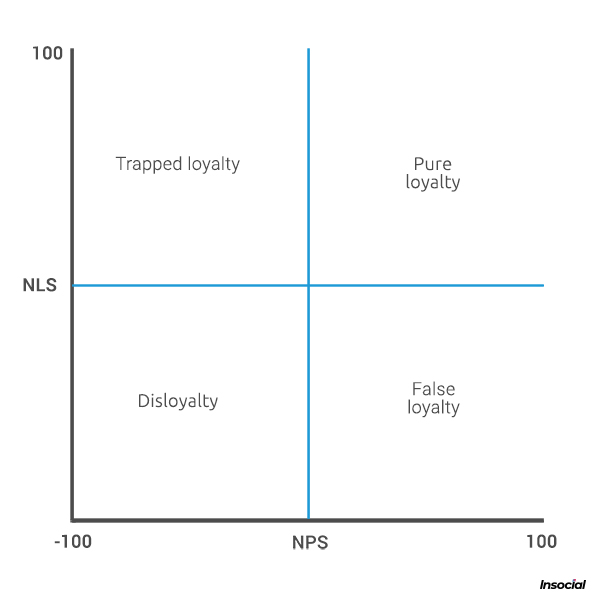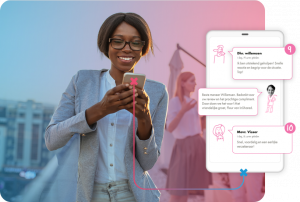You are probably already familiar with the Net Promoter Score, or NPS. A metric that gives you insight into the extent to which customers would recommend your company to others. This indicates how loyal customers are (otherwise they wouldn’t recommend you). But did you also know that there is a Net Loyalty Score (NLS)? This metric focuses even more on customer loyalty than the NPS. How it works and what the differences are? We’ll explain it to you here!
How does the Net Promoter Score work?
The NPS question is: “How likely is it that, on a scale of 0 to 10, you would recommend company X to family, friends and colleagues? By asking this question, you know whether you are performing so well that customers would recommend you. A recommendation is a favourable form of advertising, and above all, free of charge. Because a potential customer believes and trusts a friend, acquaintance or colleague rather than the commercial expressions of your company.
Respondents are divided into three groups based on their given grade. Detractors, passives and promoters. The promoters are very satisfied with the brand and/or product and will recommend it to someone else. Passives are reasonably satisfied, but when there is a better or cheaper offer, they will switch to the competitor. Detractors would discourage rather than recommend your company and are therefore not good for your reputation.

> Many detractors a lost cause? No way! With Insocial’s customer feedback software you can immediately pick up feedback from your detractors and satisfy these customers again. Wondering how Insocial can do this for you? Read it here.
How does the Net Loyalty Score work?
NLS stands for Net Loyalty Score. And where the NPS is all about promoting a brand (and thus giving an indication of loyalty), this rating is really about loyalty. This metric measures to what extent the customer is inclined to return to your company. In other words: how loyal is the customer to your company?
Contrary to the NPS, there is not yet one standard question for the NLS. You could ask the NLS in several ways, such as:
“On a scale of 0 to 10, how would you assess your loyalty to [company X]?”
This question is especially clear for your organization itself. But perhaps a little less for your respondent. That is why you could also ask the NLS in the following way:
“On a scale of 0 to 10, ‘how likely is it that you will return to [company X]?”
As with NPS, the NLS has three groups of respondents. Detractors, passives and promoters. The score is also calculated in the same way. Namely by reducing the percentage of promoters with the percentage of detractors. Here is a number between -100 and 100.
So the NLS is more about your existing customers and keeping these customers. However, external factors such as location and convenience do influence this score. For example, when someone wants to do their shopping, in most cases they go to the nearest supermarket. This while they might like the experience in another supermarket more.
> Know how to keep your existing customers? Read the tips in our article: ‘why customer retention is so important’.
NPS, NLS or both?
Which KPI can you best use? This actually depends on the goals you have set. Do you want to focus on brand awareness and acquiring new customers? Then you better measure the NPS, because this metric asks for a recommendation. Do you want to give more attention to the retention of your existing customers? Then you’d better ask the NLS, which gives you direct insight into the loyalty of your customers.
Are you asking for both metrics? Then you also get very interesting insights! Because what does it mean when a customer gives you a high grade on one question, but a low grade on the other?

The NPS layer and the NLS layer = disloyalty
Here it means that the customer won’t recommend you and won’t return. A very dissatisfied customer who is not loyal at all.
The NPS high and the NLS low = false loyalty
In this case, the customer would like to recommend you (and is certainly satisfied). But the respondent would not return and use your service again. Keep in mind that other factors, such as location, can influence this.
The NPS low and the NLS high = trapped loyalty
The customer is not satisfied enough to recommend you, but apparently to return. Other factors can also play a role here. For example, does the customer have no other choice to purchase the service from your company? Or does the customer return purely out of convenience or price advantage and not because he really appreciates the experience?
The NPS high and the NLS high = pure loyalty
The customer recommends your company and returns! A true ambassador of your brand who will stay with you for a longer period of time.
In the end, both the NPS and the NLS give a very good representation of customer satisfaction and customer loyalty. However, there are some factors that need to be taken into account when measuring loyalty, such as distance and ease of use. You could ask more in-depth questions in your survey, so you can be sure with what reason the customer is buying your product or coming to your store. Are they buying it because your product is their favorite or simply because you’re the easiest to reach?




